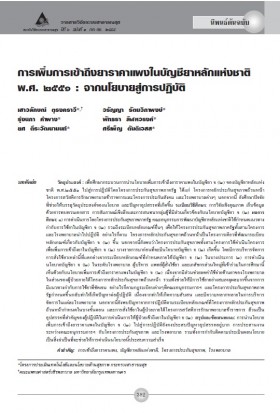This website uses cookies so that we can provide you with the best user experience possible. Cookie information is stored in your browser and performs functions such as recognising you when you return to our website and helping our team to understand which sections of the website you find most interesting and useful.
การเพิ่มการเข้าถึงยาราคาแพงในบัญชียาหลักแห่งชาติ พ.ศ.2551 : จากนโยบายสู่การปฏิบัติ (2555)

รายละเอียดเพิ่มเติม
Objectives: to study the process of implementation of the increasing access to high-cost medicine listed in the Category E2 of the 2008 NLEM policy to practice under public health insurance systems: the Universal Health Coverage scheme (UC), Civil Servant Medical Benefit Scheme (CSMBS), and Social Security Scheme (SSS) and in hospitals as well as to explore factors that promote policy achievement and problems occurred during policy implementation. Methods: A qualitative approach was employed including review and analysis of relevant documents. In-depth interviews and focus group discussions with stakeholders, who involved in the Category E2, were conducted.
Results: 1) The policy implementation under public health insurance schemes: The NLEM subcommittee created the Category E2 guidelines including other rules and regulations for the three public health insurance schemes to follow. However, the UC was the only scheme which developed its internal regulations related to the Category E2. Moreover, it was also found that the three public health insurance schemes had implemented some projects to increase access to some medicine listed in the Category E2 before the policy initiation. Also, these projects were, in some respects, managed differently from the rules and regulations of the Category E2 policy. 2) The implementation of the Category E2 policy in hospitals: Most administrators, clinicians and pharmacists who involved in this study agreed with the policy of increasing access to expensive medicines.
The implementation of this policy would reduce hospital expenditure on medicines particularly medicines for patients who were covered under the UC and promote a rational use of the medicine under the clear guidelines. However, the rules and regulations regarding the Category E2 that developed by the NLEM subcommittee and the three public health insurance schemes could cause problems in practice because it may introduce confusion and various management systems in hospitals. There were also some problems of compliance with the rules and regulations of the UC and prescription for people under the CSMBS coverage. These problems were obstacles for patients’access to medicines listed in the Category E2.
Conclusions and suggestions: Policy implementation of increasing access to the Category E2 to practice faced many barriers. Coordination among the NLEM subcommittee, public health insurance schemes, and hospitals as well as policy monitoring and evaluation were necessary and facilitated the success of policy implementation.




